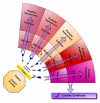A clinically integrated curriculum in evidence-based medicine for just-in-time learning through on-the-job training: the EU-EBM project
- PMID: 18042271
- PMCID: PMC2228282
- DOI: 10.1186/1472-6920-7-46
A clinically integrated curriculum in evidence-based medicine for just-in-time learning through on-the-job training: the EU-EBM project
Abstract
Background: Over the last years key stake holders in the healthcare sector have increasingly recognised evidence based medicine (EBM) as a means to improving the quality of healthcare. However, there is considerable uncertainty about the best way to disseminate basic knowledge of EBM. As a result, huge variation in EBM educational provision, setting, duration, intensity, content, and teaching methodology exists across Europe and worldwide. Most courses for health care professionals are delivered outside the work context ('stand alone') and lack adaptation to the specific needs for EBM at the learners' workplace. Courses with modern 'adaptive' EBM teaching that employ principles of effective continuing education might fill that gap. We aimed to develop a course for post-graduate education which is clinically integrated and allows maximum flexibility for teachers and learners.
Methods: A group of experienced EBM teachers, clinical epidemiologists, clinicians and educationalists from institutions from eight European countries participated. We used an established methodology of curriculum development to design a clinically integrated EBM course with substantial components of e-learning. An independent European steering committee provided input into the process.
Results: We defined explicit learning objectives about knowledge, skills, attitudes and behaviour for the five steps of EBM. A handbook guides facilitator and learner through five modules with clinical and e-learning components. Focussed activities and targeted assignments round off the learning process, after which each module is formally assessed.
Conclusion: The course is learner-centred, problem-based, integrated with activities in the workplace and flexible. When successfully implemented, the course is designed to provide just-in-time learning through on-the-job-training, with the potential for teaching and learning to directly impact on practice.
Figures



References
-
- Sackett DL, Richardson WS, Rosenberg W, Haynes RB. Evidence-Based Medicine. London, England: Churchill Livingstone Inc; 1997.
-
- Harden RM, Laidlaw JM. Effective continuing education: the CRISIS criteria. Med Educ. 1992;26:408–422. - PubMed
MeSH terms
LinkOut - more resources
Full Text Sources
Research Materials
Miscellaneous

